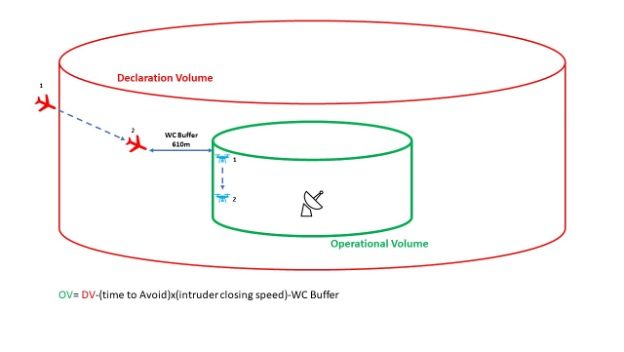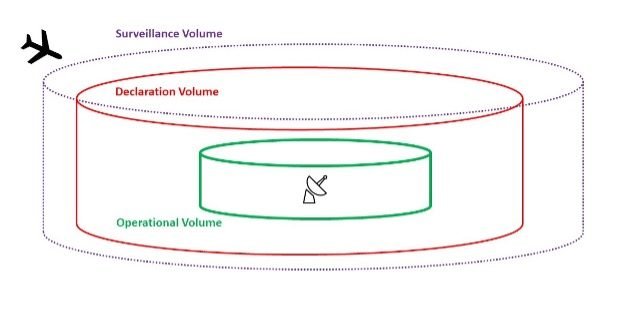In the fascinating article titled “Understanding Surveillance, Declaration, and Operational Volume in Advanced Drone Operations,” an expert from MatrixSpace unravels the complex concepts of surveillance, declaration, and operational volume in the realm of advanced drone operations. The RTCA DO-381A Ground-based Surveillance System (GBSS) Standard serves as a crucial guide, providing definitions for surveillance volume, declaration volume, and operational volume. From the surveillance volume, which encompasses the area covered by at least one ground-based sensor (GBS), to the declaration volume, referring to the space where a sensor can declare the track for air traffic, to the operational volume, which determines the safe operating area for the drone using GBSS track data – each dimension plays a vital role. Moreover, various factors, such as declaration range, intruder speed, avoidance maneuver time, and more, influence the operational volume. This comprehensive understanding allows for adjustments to be made concerning operational altitudes, UAV speeds, and other variables, ultimately impacting the drone’s operational area. To determine the exact dimensions of this area, system integrators must consider specific locations and circumstances, ensuring the safety and efficiency of advanced drone operations.
Understanding Surveillance
Surveillance in advanced drone operations refers to the monitoring and tracking of drones within a specific area. It involves the use of ground-based sensors (GBS) to gather data on the drone’s position, altitude, speed, and other relevant information. This data is crucial for maintaining safety and efficiency in drone operations.
One important concept in surveillance is the surveillance volume. This refers to the area where at least one ground-based sensor has coverage. The surveillance volume is like an “invisible bubble” that surrounds the drone and allows it to be tracked and monitored. It defines the boundaries within which the drone can be effectively tracked by the ground-based sensors.
Ground-based sensors (GBS) play a critical role in surveillance volume. These sensors are strategically placed on the ground and communicate with the drone to gather information about its position and other relevant data. The GBS act as the “eyes” of the surveillance system, ensuring that the drone remains within the designated surveillance volume.
Understanding Declaration
Declaration in advanced drone operations refers to the process of a sensor within the surveillance volume declaring the track of a drone. When a sensor declares a track, it means that it has identified the drone and is actively tracking its movements. This declaration is essential for air traffic control and ensures that the drone is properly accounted for within the airspace.
The declaration volume is the area inside the surveillance volume where at least one sensor has the capability to declare the track of a drone. It is a subset of the surveillance volume and defines the specific area where a sensor can actively track and declare the drone’s track. The declaration volume is crucial for maintaining situational awareness and ensuring the safety of both the drone and other airspace users.
Effective sensor declaration is vital for air traffic control as it provides real-time information about the drone’s position and movement. This information allows air traffic controllers to safely manage the drone’s operations and prevent any potential conflicts with other aircraft. The declaration volume plays a critical role in enabling accurate and timely tracking information to be provided to air traffic control.

This image is property of dronelife.com.
Understanding Operational Volume
Operational volume in advanced drone operations refers to the volume in which the drone can safely operate within its performance specifications. It takes into account factors such as the drone’s capabilities, airspace restrictions, and operational requirements. The operational volume is a dynamic concept that can change based on various factors.
The operational volume is closely related to surveillance volume and declaration volume. It utilizes the track data provided by the ground-based surveillance system (GBSS) to determine the boundaries within which the drone can safely operate. The GBSS track data allows for real-time monitoring of the drone’s position and ensures that it stays within the designated operational volume.
Several factors influence the operational volume of a drone. These factors include the declaration range, intruder speed, avoidance maneuver time, and other variables. The declaration range is the maximum distance at which a sensor can accurately declare the track of a drone. Intruder speed refers to the speed at which other aircraft or objects may approach the drone’s operational area. The avoidance maneuver time is the time required for the drone to respond to a potential conflict and execute a safe maneuver.
These factors, along with other variables, play a crucial role in determining the operational volume. By adjusting these variables, drone operators can expand or restrict the operational area of the drone. This flexibility is essential for adapting to different operational requirements and maintaining the highest level of safety.
RTCA DO-381A Ground-based Surveillance System (GBSS) Standard
The RTCA DO-381A Standard is a widely recognized standard that provides guidelines and requirements for the implementation of ground-based surveillance systems (GBSS). This standard is specifically designed for advanced drone operations and offers definitions for surveillance volume, declaration volume, and operational volume.
The standard defines surveillance volume as the area where at least one ground-based sensor has coverage. It establishes the criteria for determining the extent and boundaries of the surveillance volume. By following the guidelines outlined in the standard, drone operators can ensure that the surveillance volume is effectively defined and monitored.
Declaration volume is also defined by the RTCA DO-381A Standard. It specifies that the declaration volume is the area within the surveillance volume where at least one sensor can declare the track for air traffic. The standard outlines the importance of accurate declaration within this volume to ensure the safety and efficiency of drone operations.
Operational volume is another concept addressed by the RTCA DO-381A Standard. The standard provides a clear definition and purpose for the operational volume, emphasizing the importance of utilizing GBSS track data to determine the boundaries within which the drone can safely operate.
Overall, the RTCA DO-381A Standard serves as a valuable reference for drone operators and system integrators in implementing ground-based surveillance systems. It ensures a common understanding and consistent application of surveillance, declaration, and operational volumes in advanced drone operations.

This image is property of dronelife.com.
Surveillance Volume
Surveillance volume is a critical aspect of advanced drone operations, as it defines the area within which the drone can be effectively monitored and tracked. The surveillance volume is determined by the coverage of at least one ground-based sensor (GBS). As long as the drone remains within this volume, it can be continuously monitored by the ground-based sensors.
The coverage of a ground-based sensor refers to its ability to detect and track the drone. The surveillance volume extends to the farthest point where the sensor can effectively detect the drone’s presence. This ensures that the drone remains within the range of the surveillance system and allows for real-time monitoring of its movements.
The extent and boundaries of the surveillance volume are determined based on various factors such as the capabilities of the ground-based sensors, terrain features, and airspace restrictions. These factors influence the range and effectiveness of the surveillance system. By understanding the surveillance volume, drone operators can ensure that their operations remain within the designated area of coverage.
Declaration Volume
Declaration volume is a subset of the surveillance volume and plays a crucial role in air traffic control. It refers to the area within the surveillance volume where at least one ground-based sensor has the capability to declare the track of a drone. The declaration volume is essential for providing real-time tracking information to air traffic control and ensuring the safe integration of drones into the airspace.
The declaration volume is determined based on the capabilities of the sensors within the surveillance volume. These sensors must have the ability to accurately and consistently track the drone’s position and movement. By defining the boundaries of the declaration volume, drone operators can ensure that air traffic control has access to timely and reliable tracking data.
The role of sensor declaration in air traffic control is critical for maintaining situational awareness and preventing conflicts with other aircraft. When a sensor within the declaration volume declares the track of a drone, air traffic control can proactively manage the drone’s operations and make informed decisions regarding airspace utilization.
Determining the boundaries of the declaration volume involves considering factors such as the accuracy and range of the sensors, as well as any airspace restrictions. By carefully defining the declaration volume, drone operators can ensure that the necessary tracking information is provided to air traffic control, thereby enhancing safety and efficiency in drone operations.

This image is property of dronelife.com.
Operational Volume
Operational volume refers to the volume in which a drone can safely operate within its performance specifications. It takes into account various factors such as the drone’s capabilities, operational requirements, and airspace restrictions. The operational volume is a dynamic concept that can be adjusted based on specific operational needs and conditions.
The operational volume is closely tied to the surveillance volume and declaration volume. It relies on the use of ground-based surveillance system (GBSS) track data to define the boundaries within which the drone can safely operate. By utilizing this track data, drone operators can ensure that the drone remains within the designated operational volume.
Several factors influence the operational volume of a drone. These factors include the declaration range, intruder speed, avoidance maneuver time, and other variables. The declaration range is the maximum distance at which a ground-based sensor can accurately declare the track of the drone. Intruder speed refers to the speed at which other aircraft or objects may approach the drone’s operational area. The avoidance maneuver time is the time required for the drone to respond to a potential conflict and execute a safe maneuver.
Adjusting these variables allows drone operators to expand or restrict the operational area based on specific needs and conditions. For example, increasing the declaration range or allowing for faster avoidance maneuver times can expand the operational volume. Conversely, reducing these variables can result in a smaller operational volume. By carefully considering these factors, drone operators can optimize the operational volume to meet their operational objectives while maintaining safety.
Determining Factors for Operational Volume
Several factors influence the operational volume of a drone in advanced drone operations. These factors play a crucial role in determining the boundaries within which the drone can safely operate. By understanding these factors, drone operators can make informed decisions regarding the operational volume and ensure the highest level of safety and efficiency.
One determining factor for the operational volume is the declaration range. The declaration range defines the maximum distance at which a sensor within the surveillance volume can accurately declare the track of the drone. A longer declaration range allows for a larger operational volume, as the drone can be effectively tracked over a greater distance.
The intruder speed is another factor that affects the operational volume. Higher intruder speeds require a larger operational volume to ensure safe separation between the drone and other aircraft or objects. The operational volume must account for the potential movements of intruders to prevent any conflicts or collisions.
Avoidance maneuver time also influences the operational volume. This refers to the time required for the drone to respond to a potential conflict and execute a safe maneuver. A shorter avoidance maneuver time allows for a smaller operational volume, as the drone can quickly adjust its position to avoid any potential conflicts.
Other variables can also impact the operational volume, such as the drone’s capabilities, airspace restrictions, and operational requirements. By considering these factors, drone operators can determine the optimal operational volume that meets their specific needs while ensuring safety.

This image is property of dronelife.com.
Impact of Adjustments on Operational Area
Adjustments to various parameters can significantly impact the operational area of a drone in advanced drone operations. These adjustments are crucial for maintaining safety and optimizing operational efficiency. Understanding the impact of these adjustments allows drone operators to make informed decisions regarding their operational area.
One significant adjustment relates to operational and safe altitudes. By adjusting these altitudes, drone operators can expand or restrict the vertical space within which the drone can safely operate. This adjustment is essential for accommodating other airspace users and ensuring separation between aircraft.
The speed of the drone also has a significant impact on the operational area. Higher speeds allow the drone to cover more ground within a given time frame, thereby expanding the operational area. Conversely, slower speeds may limit the drone’s operational area, especially when time constraints are a factor.
Other factors, such as weather conditions, airspace restrictions, and operational requirements, can also influence the operational area. By considering these factors and making appropriate adjustments, drone operators can optimize the operational area for their specific mission or task.
Analyzing the effects of these adjustments on the operational volume is crucial for maintaining safety and efficiency. It allows drone operators to determine the best course of action to ensure that the operational area remains within acceptable limits and aligns with operational objectives.
Determining the Exact Dimensions of Operational Area
The determination of the exact dimensions of the operational area in advanced drone operations is a complex process that requires careful consideration of various factors. System integrators play a crucial role in this process, as they have the knowledge and expertise to analyze the specific requirements of a given location and circumstance.
System integrators consider several factors when determining the exact dimensions of the operational area. These factors include the characteristics of the drone, such as its performance specifications and maneuverability. They also take into account the airspace restrictions and regulations that may impact the operational area.
Specific locations and circumstances require tailored approaches to determine the operational area dimensions. For example, operations in urban areas may have more stringent restrictions due to higher population densities and increased risk factors. Similarly, operations in controlled airspace or near airports may require additional considerations to ensure compliance with air traffic control regulations.
Methods used to determine the exact dimensions of the operational area may vary depending on the specific requirements. These methods can include simulation and modeling techniques, data analysis, and expert judgment. By utilizing a combination of these methods, system integrators can provide accurate and comprehensive information regarding the operational area.
In conclusion, understanding surveillance, declaration, and operational volume is crucial for safe and efficient advanced drone operations. The RTCA DO-381A Ground-based Surveillance System (GBSS) Standard provides valuable definitions and guidelines for these concepts. By carefully considering the various factors and making necessary adjustments, drone operators can optimize the operational area and ensure the highest level of safety and operational efficiency. System integrators play a crucial role in determining the exact dimensions of the operational area based on specific locations and circumstances. By following these guidelines and working with knowledgeable experts, drone operators can pave the way for successful and responsible drone operations.



